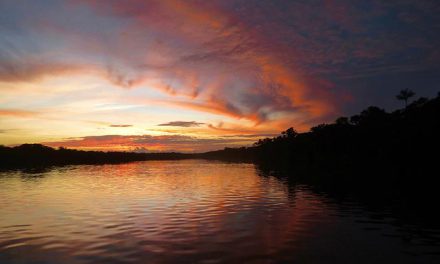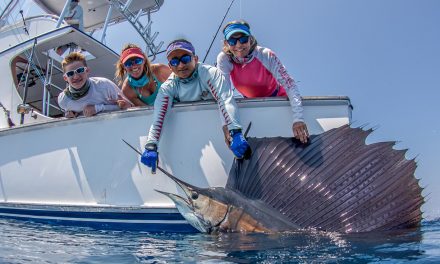By Pat Ford
Mahi, aka dolphin fish, may very well be the perfect gamefish! It’s plentiful if you know when and where to look. It’s a surface dwelling, migratory, carnivorous critter that roams offshore in temperate, tropical and sub-tropical waters…in other words, it can be found pretty much everywhere there’s a warm ocean. It’s appetite is voracious…it will eat just about anything which makes it very angler friendly. It has a slender and long body that is built for speed. It is sexually mature at one year with females spawning 3 or 4 times a year with 80,000-100,000 eggs per event. Mahi rarely live more than 4 years, but can reach weights close to 100 lbs on rare occasion. Weight increases in proportion to food supply and while a 40 pounder is a trophy, the official IGFA all tackle record is 87lbs. It’s coloring is magnificent. Unstressed it’s a light blue but when hooked its coloring changes from iridescent blue to green to yellow in amazing sequences.
Almost anyone who has access to an offshore boat in the USA’s southern coastline has caught dolphin. The summer months seem to be the best probably due to warmer water temperatures, calmer seas and more boats on the water. In South Florida, July and August seem to be the best months to catch a trophy, but mahi seem to pop up occasionally all year round. The smaller mahi travel in schools and tend to hang around floating debris. It doesn’t seem to matter what the debris is but the bigger it is and the longer it’s been in the water, the more likely it will attract and hold mahi. I’ve found them around single plastic jugs and all the way upthe flotsum chain to floating palm trees. Floating debris attracts juvenile fish of many species, which attract baitfish such as small jacks, which in turn provide a sturdy food supply for the cruising mahi.
The standard procedure for fishing for mahi in Florida consists of finding a weedline and trolling along it. The most common bait is a ballyhoo, usually behind feathers, but trolling lures probably is just as effective. When a dolphin is hooked, the trick is to fight it up to the boat, but don’t gaff it. Keep it in the water and the school will follow it right up to the boat. Chumming with live pilchards or a few chunks of cut bait will keep the school feeding and limits can be caught without even starting up the engine. They can be caught on light tackle with bait, jigs or surface plugs…even on fly rods. As long as you keep one fish in the water, the carnage can continue. Unfortunately for the species, no one releases mahi until they’ve met their limit.
The average mahi in Florida are probably 5 to 12 lbs, which is the size that travels in schools. When the mahi get over 15 lbs they tend to travel in pairs – a bull and a cow. If one is hooked, the other will stay with it right up to the boat unless it hits one of the other lines that are out. Double hook-ups while trolling are common.
Just before my trip to Tropic Star Lodge in Panama a friend of mine was there and reported that the mahi bite was in full swing. So much so that the anglers decided to have a one day dolphin rodeo. My buddy ‘s boat caught a massive mahi right off the bat – over 5’ long and they figured they had the contest in the bag, so they went back to chasing marlin. At the end of the day their dolphin weighed 64 lbs….and came in 4th. The winner was 73 lbs. Man do I want a shot at one of those monsters on a fly rod. As it turned out the Ocean Candy was magic….the mahi loved it. We caught several in the 30 lb range and hooked up one that was probably over 50 lbs, but it spit the hook after several jumps.I’m confident that a fly rod world record mahi could come out of Tropic Star in the near future. The only deterrent is that the boat will have to ignore marlin and spend the majority of it’s time searching for dolphin. That’s a very difficult choice to make and most everyone follows my pattern of marlin fishing and leaving the mahi as a bycatch.If you want to set a record, you’ll have to get one of the few captains who understand fly fishing and you’ll have to be focused.
No matter which coast you are on , mahi are always a possibility and a very welcome addition to a days catch. As I mentioned, it doesn’t matter what you’re fishing for or what method of fishing you’re using, if a mahi spots your bait, it will probably bite it. All they do is eat. They key is to be ready for them with some light tackle rods rigged and ready to go whenever you’re in mahi country.




























Hello! Someone in my Facebook group shared this
site with us so I came to take a look. I’m definitely loving the information. I’m bookmarking and will
be tweeting this to my followers! Outstanding blog and great design and style.